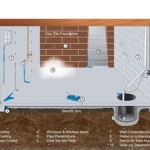What Does A Sump Pump Do In Basement?
A sump pump is a crucial device installed in the basement of many homes, particularly in areas prone to flooding or with high water tables. Its primary function is to remove accumulated water from a sump pit, preventing it from entering and damaging the basement. Understanding the purpose, operation, and maintenance of a sump pump is essential for homeowners seeking to protect their property from water damage.
The presence of water in a basement can lead to a multitude of problems, including structural damage to the foundation, mold and mildew growth, destruction of personal belongings, and health hazards. A sump pump acts as a proactive measure to mitigate these risks by automatically removing water before it reaches problematic levels. It is an integral part of a comprehensive basement waterproofing system.
The effectiveness of a sump pump relies on several factors, including the proper installation, the correct sizing of the pump for the specific conditions, and regular maintenance. Neglecting these aspects can lead to pump failure and subsequent water damage. Therefore, homeowners should prioritize understanding the nuances of sump pump operation and maintenance.
Preventing Basement Flooding
The most important role of a sump pump is to prevent basement flooding. Basements are inherently susceptible to water accumulation due to their location below ground level. Groundwater, rainwater runoff, and even plumbing leaks can contribute to water seepage into the basement. The purpose of the sump pump is to collect this water in a designated sump pit and then expel it away from the foundation of the house.
The sump pit is a basin, usually constructed of plastic or concrete, embedded in the basement floor. It serves as a collection point for water that accumulates around the foundation. Water enters the pit through natural drainage of the surrounding soil or through drain tiles that are strategically placed around the perimeter of the basement foundation. These tiles collect groundwater and direct it towards the sump pit.
When the water level in the sump pit reaches a predetermined point, the sump pump is automatically activated. This activation is typically triggered by a float switch, which rises with the water level. As the float reaches the activation point, it turns on the pump, initiating the water removal process. The pump then draws water from the pit and discharges it through a pipe that leads away from the house, ideally to a location that allows the water to drain away from the foundation.
The discharge location is critical. It should be far enough away from the foundation to prevent the water from simply flowing back into the basement. Common discharge locations include a storm drain, a dry well specifically designed for water runoff, or a designated area of the yard that slopes away from the house. Local regulations may dictate the permissible discharge locations, so it is essential to comply with these regulations during installation.
Without a functioning sump pump, water would continue to accumulate in the basement, eventually leading to flooding. Even small amounts of standing water can cause significant damage over time. The sump pump provides a reliable mechanism for managing this water and preventing the associated problems.
Protecting Structural Integrity
Beyond the immediate concern of flooding, a sump pump plays a crucial role in protecting the structural integrity of the home's foundation. Excessive moisture around the foundation can lead to hydrostatic pressure, which is the pressure exerted by water on the surrounding soil and concrete. This pressure can cause cracks and fissures in the foundation walls, ultimately weakening the structure.
Hydrostatic pressure arises when the soil surrounding the foundation becomes saturated with water. As the water table rises, the pressure exerted on the foundation walls increases. Over time, this pressure can cause the foundation to shift, crack, or even bow inwards. These structural problems can be expensive to repair and can compromise the safety of the building.
A sump pump helps to alleviate hydrostatic pressure by removing excess water from the soil surrounding the foundation. By keeping the water table at a manageable level, the pump reduces the amount of pressure exerted on the foundation walls. This, in turn, minimizes the risk of cracks, fissures, and other structural damage.
The drain tile system that feeds into the sump pit is also instrumental in protecting the foundation. These tiles are designed to collect groundwater and direct it away from the foundation walls. By intercepting the water before it has a chance to saturate the surrounding soil, the drain tiles further reduce hydrostatic pressure. The combined effect of the drain tiles and the sump pump provides a comprehensive system for foundation protection.
Furthermore, excessive moisture in the soil can contribute to soil erosion and settling around the foundation. This can lead to uneven settling of the house, causing cracks in walls, ceilings, and floors. By managing water levels, a sump pump helps to maintain the stability of the soil and prevent these problems.
Maintaining a dry basement also helps to prevent the corrosion of metal components in the foundation, such as rebar and support beams. Corrosion can weaken these components, further compromising the structural integrity of the building. By keeping the basement dry, a sump pump helps to prolong the lifespan of these critical structural elements.
Mitigating Mold and Mildew Growth
Another significant benefit of a sump pump is its ability to mitigate mold and mildew growth in the basement. Mold and mildew thrive in damp, humid environments. Basements, due to their underground location and potential for water accumulation, are particularly susceptible to mold and mildew problems.
Mold and mildew not only cause unpleasant odors and discoloration but can also pose serious health risks. Exposure to mold spores can trigger allergic reactions, respiratory problems, and other health issues. Individuals with asthma, allergies, or weakened immune systems are particularly vulnerable to the effects of mold exposure.
By removing excess water from the basement, a sump pump helps to create a drier, less hospitable environment for mold and mildew growth. The pump reduces the humidity levels in the basement, making it more difficult for mold and mildew to flourish. This is particularly important in areas with high humidity or frequent rainfall.
Even small amounts of standing water can provide a breeding ground for mold and mildew. Leaks from plumbing fixtures, condensation on cold surfaces, and seepage through foundation walls can all contribute to moisture accumulation in the basement. A sump pump helps to address these issues by removing the water before it has a chance to promote mold growth.
In addition to preventing mold and mildew growth, a sump pump can also help to reduce the risk of insect infestations. Many insects, such as termites, cockroaches, and silverfish, are attracted to damp environments. By keeping the basement dry, a sump pump makes it less appealing to these pests.
To further prevent mold and mildew growth, it is important to address any sources of moisture in the basement. This may involve repairing leaks, improving ventilation, and sealing cracks in the foundation walls. Combining these measures with the use of a sump pump can create a healthy and comfortable basement environment.
Regular inspection of the basement for signs of moisture, mold, or mildew is crucial. Early detection of these problems allows for prompt remediation, preventing them from escalating into more serious issues. A proactive approach to basement maintenance, including the use of a sump pump, is essential for protecting the health and safety of the home and its occupants.
Therefore, a sump pump is not just a device to remove water; it's a guardian against a host of potential basement-related problems, contributing significantly to the overall health and structural integrity of a home.

Reasons To Install A Sump Pump Bdb Waterproofing

Prevent Basement Flooding The Role Of Sump Pumps In Water Management Dry Foundation Repair

Basement Sump Pumps Zoeller Pump Company

What Is A Sump Pump How Do They Work Learn More

What Is A Sump Pump And How Does It Work Fresh Water Systems

Diy Sump Pump Install Your Own Smd Fluid Controls

Sump Pump Installation In Pa De Dry Tech Waterproofing Solutions

Steps For Maintaining Your Sump Pump Ashworth Drainage

What Is A Sump Pump And How Does It Work Forbes Home

How To Check Your Sump Pump Prevent Basement Flooding







